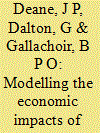| Srl | Item |
| 1 |
ID:
113473


|
|
|
|
|
| Publication |
2012.
|
| Summary/Abstract |
This paper investigates the impacts of including 500 MW of wave power into Ireland's electricity generation portfolio in the year 2020. One year of detailed market simulations are undertaken to determine the impact on wholesale electricity prices, system operation costs and CO2 emissions with and without this installed wave power under a number carbon prices assumptions. In both scenarios (with and without wave energy), Ireland's installed renewable capacity is fixed such that 40% of Ireland's electricity in 2020 is from renewable source. The likely revenue a wave energy device would earn in the market is also investigated and compared with what is required to achieve 500 MW installed capacity. It is shown that in general the inclusion of wave energy has a negligible effect on wholesale electricity prices, reduces total system cost in Ireland and can increase CO2 emissions on the island of Ireland under certain carbon price assumptions. It is also shown the current REFIT for wave energy is adequate.
|
|
|
|
|
|
|
|
|
|
|
|
|
|
|
|
| 2 |
ID:
125508


|
|
|
|
|
| Publication |
2013.
|
| Summary/Abstract |
This paper focuses on the impact of electric vehicles on electricity generation in Ireland in 2025 based on five alternative generation portfolios. The year 2025 was selected for assessment due to the information on the composition of the five generation portfolios from Eirgrid the system operator in Ireland being provided. Detailed market simulations were undertaken on the five possible generation portfolios to assess the impact of the Government targets for electric vehicles on the generation costs, emissions, generation stack and the cost to load of this additional demand. This paper also studied the impact between a standard and least cost electric vehicle loading regime to ascertain the benefits that could be achieved. The results show that gas will be the dominant source of electricity generation to load electric vehicles and that wind as an electricity source will experience a minor reduction in curtailment, with the least cost charging profile showing a more pronounced reduction. The capital benefits of the Standard and Least Cost EV load are found to be negligible. The portfolios studied generated CO2 emissions per kilometre between 52 and 70 gCO2/km. All portfolios with the exception of coal were found to comply with EU regulation 443/2009.
|
|
|
|
|
|
|
|
|
|
|
|
|
|
|
|
| 3 |
ID:
125859


|
|
|
|
|
| Publication |
2013.
|
| Summary/Abstract |
This paper focuses on Ireland's ambitious target for 2020 to reduce greenhouse gas (GHG) emissions by 20% below 2005 levels for sectors not covered by ETS (Non-ETS). Ireland is an interesting case study due to the role of agriculture (a particularly challenging sector with regard to GHG emissions reduction), that represents 29% of Ireland's GHG emissions compared with less than 10% for the EU. The analysis is carried out with the Irish TIMES model, a bottom-up energy systems modelling tool with detailed characterization of Ireland's energy system. The paper uses scenario analysis to provide pathways that demonstrate how Ireland can meet the non-ETS target at least cost. The paper considers the impacts (in terms of different technology choices and higher marginal abatement costs) arising from higher targets for the energy system to compensate for growth in agriculture activity and low mitigation potential in that sector. The results point to a need to reconsider Ireland's renewable energy focus, with a need for increased effort in renewable transport and renewable heat in particular. The results also point to significant electrification of residential heating. The results also point to a high marginal abatement cost (€213/tCO2), which challenges the analysis carried out at EU level to establish Ireland's non-ETS target.
|
|
|
|
|
|
|
|
|
|
|
|
|
|
|
|
| 4 |
ID:
117317


|
|
|
|
|
| Publication |
2013.
|
| Summary/Abstract |
The Copenhagen Accord established political consensus on the 2 °C limit (in global temperature increase) and for deep cuts in greenhouse gas (GHG) emissions levels to achieve this goal. The European Union has set ambitious GHG targets for the year 2050 (80-95% below 1990 levels), with each Member State developing strategies to contribute to these targets. This paper focuses on mitigation targets for one Member State, Ireland, an interesting case study due to the growth in GHG emissions (24% increase between 1990 and 2005) and the high share of emissions from agriculture (30% of total GHG emissions). We use the Irish TIMES energy systems modelling tool to build a number of scenarios delivering an 80% emissions reduction target by 2050, including accounting for the limited options for agriculture GHG abatement by increasing the emissions reduction target for the energy system. We then compare the scenario results in terms of changes in energy technology, the role of energy efficiency and renewable energy. We also quantify the economic impacts of the mitigation scenarios in terms of marginal CO2 abatement costs and energy system costs. The paper also sheds light on the impacts of short term targets and policies on long term mitigation pathways.
|
|
|
|
|
|
|
|
|
|
|
|
|
|
|
|